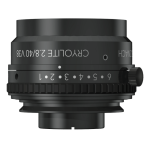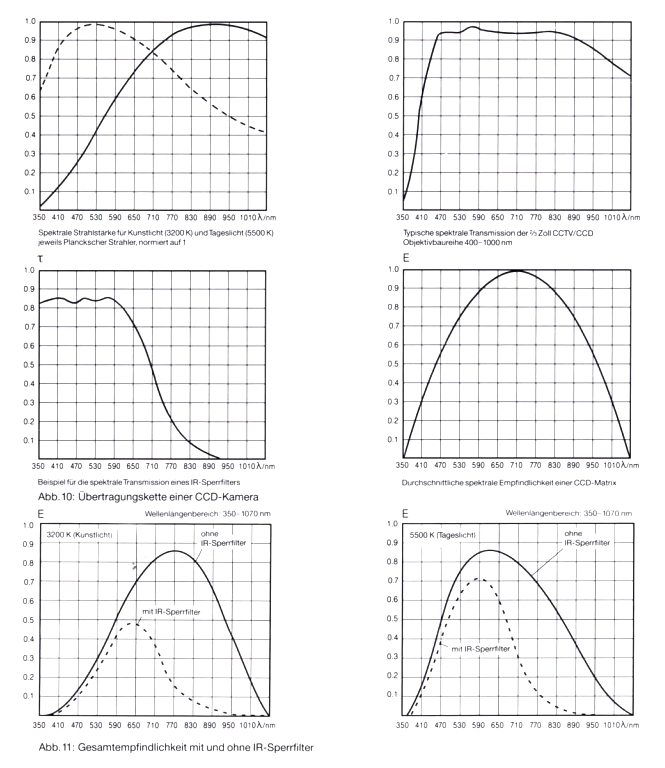Infrared-compatible lenses
If the sensitivity of the image sensor is to be used in the near infrared range, lenses must be used that have sufficient transmission and imaging performance in this wavelength range (approx. 700-1000 nm).

If the sensitivity of the image sensor is to be used in the near infrared range, lenses must be used that have sufficient transmission and imaging performance in this wavelength range (approx. 700-1000 nm).

Conventional multiple coatings (MC = multicoating) of the individual lens surfaces, as used for photographic purposes, have a transmission-reducing rather than a transmission-enhancing effect in the infrared range under consideration. Light is therefore reflected several times in the optical system and, in addition to the loss of radiant energy, can lead to undesirable secondary images, aperture spots and stray light, thus drastically impairing the image quality. Infrared-compatible lenses must therefore have optimum transmission over a wide wavelength range from visible blue light to the near infrared thanks to special coating of the lens surfaces.
The modulation transfer functions reflect the imaging quality over a certain wavelength range of light, whereby the proportions of individual wavelengths are included with different weightings. The smaller the wavelength range under consideration, the better the modulation transfer function usually is, as all chromatic aberrations (changes in image position and image size depending on the wavelength) have less influence. A lens that is to deliver good image quality over a very wide wavelength range must therefore have a very complex design and include special glasses for color correction.
This ensures that chromatic errors are kept to a minimum and that the image quality hardly changes noticeably over a relatively wide focusing range (for one object distance), which in turn means that there is practically no need to refocus when moving from one wavelength range to another in order to find the best focusing plane. In practice, this means, for example, that an image does not have to be refocused each time when moving from daylight illumination to artificial light illumination to infrared illumination (when focusing in the infrared).
The sensitivity of a camera-lens combination is also determined by the irradiance that the lens generates on the image sensor. This depends on the transmission of the lens and its relative aperture, which is indicated by the f-number k. Large relative apertures (small f-numbers) allow use down to low object radiance, i.e. down to low light conditions such as at dusk. Good image quality at very small f-numbers can only be achieved with a great deal of design effort.
The imaging performance of a lens generally decreases with the f-number. Furthermore, the focus difference increases at different wavelength ranges. With extreme relative apertures (very small f-numbers), this can lead to the wavelength range having to be restricted. In daylight, the infrared component would have to be blocked by an IR cut filter. On the other hand, refocusing would be necessary at the transition to the infrared range (without a filter).
A lens with high imaging performance over a wide wavelength range can also be used at the maximum relative aperture without an IR cut filter. It provides a greater irradiance and therefore a greater detector signal than a lens with an IR cut filter at the same f-number. The additional gain in irradiance from the IR range can be up to 1.5 or more f-stops.
This means, for example, that a lens with a minimum f-number of 1.4, which can be used without an IR cut filter due to its high imaging performance in daylight or artificial light, delivers a greater luminous flux than a lens with an aperture one f-stop larger (k=1.0), which must be used with a filter and which also has a lower overall quality for a comparable design effort.


Please do not hesitate to contact us if you have any questions. Our dedicated team is here to help you every step of the way. Whether you need assistance with product selection, technical specifications, or general inquiries.
Jos. Schneider Optische Werke GmbH
Ringstraße 132
55543 Bad Kreuznach | Germany
Tel: +49 (0) 671 601 205
isales(at)schneiderkreuznach.com
Contact form